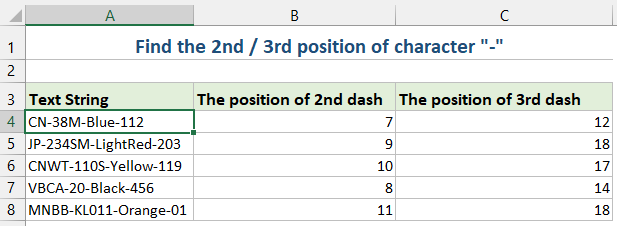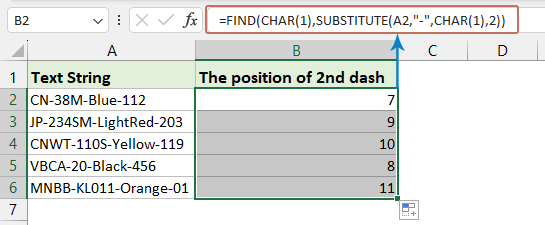Знайдіть n-те входження символу в Excel – 3 швидких способи
Пошук n-го входження певного символу в текстовому рядку в Excel може бути особливо корисним під час аналізу даних, де вам може знадобитися проаналізувати рядки або витягти інформацію на основі певних роздільників або шаблонів. Наприклад, давайте знайдемо 2-е або 3-є входження символу "-" в текстовому рядку. Я продемонструю прості методи ефективного виконання цього завдання.

Знайдіть n-е входження символу в текстовому рядку за допомогою формули
Ви можете створити формулу для знаходження n-го повторення символу. Будь ласка, зробіть так:
1. Введіть або скопіюйте наступну формулу в клітинку, де ви хочете отримати результат:
=FIND(CHAR(1),SUBSTITUTE(A2,"-",CHAR(1),2))- A2: клітинка, яка містить рядок.
- -: персонаж, якого ви шукаєте.
- 2: 2-й випадок, який ви хочете знайти, ви можете змінити його на 3,4…як вам потрібно.
2. Потім перетягніть заливку формули вниз, щоб заповнити формулу іншими комірками, і 2-а позиція символу – відображаються відразу, дивіться знімок екрана:
- ЗАМІННИК замінює n-е входження символу на недрукований символ (CHAR(1)).
- ЗНАЙТИ шукає цей недрукований символ, надаючи позицію n-го входження.
Знайдіть n-те входження символу в текстовий рядок за допомогою Kutools для Excel
Якщо ви не любитель використовувати формулу або VBA, ви можете розглянути зручну альтернативу – Kutools для Excel. У групах формул ви знайдете корисну утиліту – Знайдіть, де символ відображається N-й у рядку який швидко визначає та повертає n-ту позицію будь-якого символу в клітинці.
Після встановлення Kutools для Excel, Натисніть Кутулс > Помічник формули > Помічник формули відкрити Помічник формули діалогове вікно. Клацніть клітинку, куди потрібно помістити результат. Потім виконайте наступне:
- Select Пошук з розкривного списку Тип формули розділ;
- Вибирати Знайдіть, де символ відображається N-й у рядку in Виберіть формулу розділ;
- Виберіть комірку, яка містить рядок, який ви використовуєте, а потім введіть вказаний символ і n-е входження в текстові поля в Введення аргументів розділ;
- Нарешті клацніть OK кнопку, щоб отримати результат.

Знайдіть n-те входження символу в текстовий рядок за допомогою функції, визначеної користувачем
У цьому розділі ми розглянемо, як створити та використати UDF для пошуку n-го повторення символу в Excel, надавши покроковий посібник, який допоможе вам оптимізувати обробку даних.
- Утримуйте клавішу ALT + F11 і відкриває Microsoft Visual Basic для додатків вікна.
- Натисніть Insert > Модуліта вставте наступний макрос у вікно модуля.
Function FindN(sFindWhat As String, _ sInputString As String, N As Integer) As Integer 'Updateby Extendoffice Dim J As Integer Application.Volatile FindN = 0 For J = 1 To N FindN = InStr(FindN + 1, sInputString, sFindWhat) If FindN = 0 Then Exit For Next End Function - Потім закрийте вікно vba. Поверніться до робочого аркуша, введіть наведену нижче формулу в клітинку, а потім перетягніть маркер заповнення вниз, щоб заповнити формулою інші клітинки, див. знімок екрана:
=FindN("-",A2,3)
- Підрахуйте кількість входжень слова в стовпчик
- Якщо у вас є дані стовпця, які містять кілька повторюваних значень, як показано на знімку екрана, а тепер ви хочете підрахувати кількість повторень конкретного слова в цьому стовпці. Тепер у цьому підручнику я представляю деякі трюки, щоб швидко вирішити це питання в Excel.
- Замінити перший n символ або n-е повторення символу іншим
- В Excel ми зазвичай знаходимо та замінюємо рядок функцією Знайти та замінити, але якщо ви перебуваєте в одному з наведених нижче випадків, функція Знайти та замінити вам не може допомогти.
- Витягти n-й символ із рядка
- Загалом, ви можете витягнути рядок після певного символу, але в цьому випадку я хочу витягти n-й символ із рядка, як показано на знімку екрана нижче.
- Витягти перші/останні n символів із рядка
- Наприклад, у кожній комірці є список з довгими рядками, і ви хочете витягти перші n символів лише з кожного рядка, як перші 3 символи кожного рядка, і тепер ви можете використовувати наступні методи для його вирішення в Excel .
Статті по темі:
Найкращі інструменти продуктивності офісу
Покращуйте свої навички Excel за допомогою Kutools для Excel і відчуйте ефективність, як ніколи раніше. Kutools для Excel пропонує понад 300 додаткових функцій для підвищення продуктивності та економії часу. Натисніть тут, щоб отримати функцію, яка вам найбільше потрібна...

Вкладка Office Передає інтерфейс із вкладками в Office і значно полегшує вашу роботу
- Увімкніть редагування та читання на вкладках у Word, Excel, PowerPoint, Publisher, Access, Visio та Project.
- Відкривайте та створюйте кілька документів на нових вкладках того самого вікна, а не в нових вікнах.
- Збільшує вашу продуктивність на 50% та зменшує сотні клацань миші для вас щодня!
